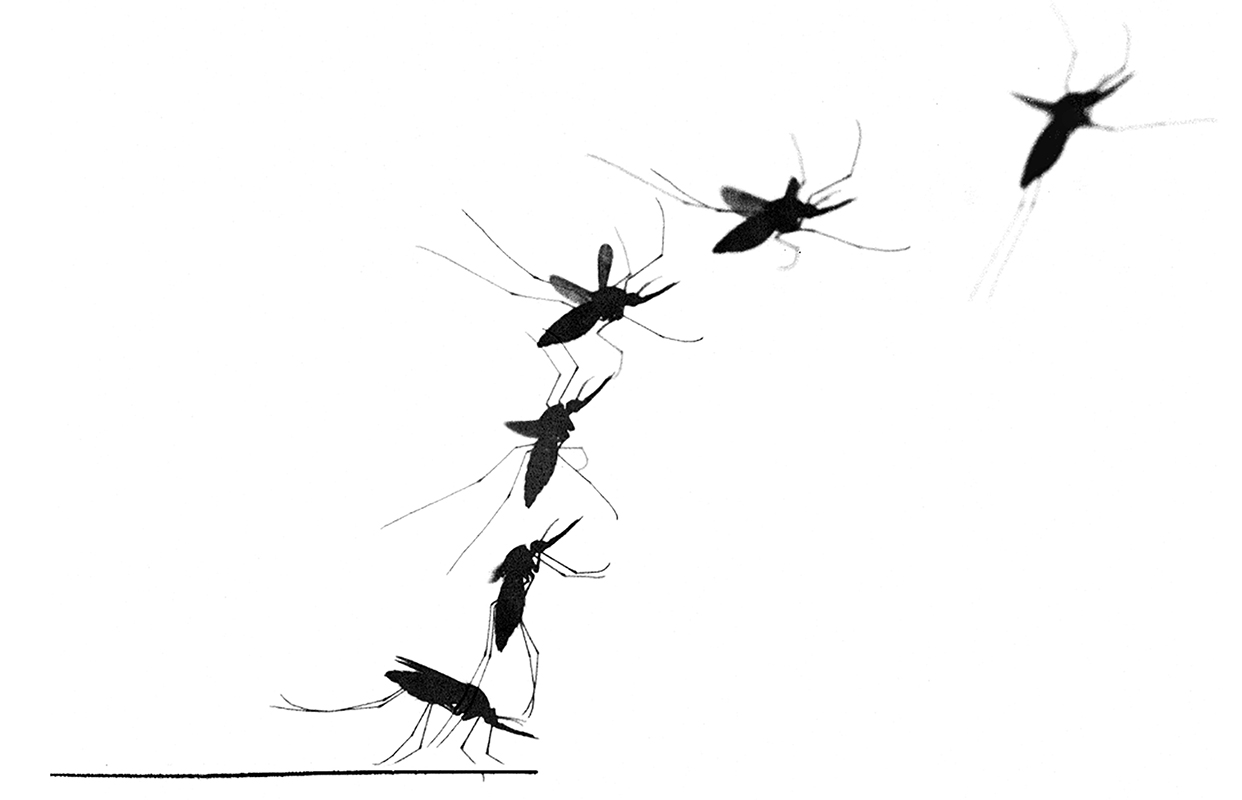How Blood-Bloated Mosquitoes Stealthily Avoid a Swat
After a mosquito bites you and drinks its fill, how does it escape quickly and sneakily, to avoid getting smacked? To make their liftoff smoother and less noticeable to their victims, blood-bloated mosquitoes adjust their takeoff technique, researchers have discovered.
Using an array of high-speed cameras and 3D-motion analysis, scientists tracked 63 takeoff maneuvers in mosquitoes, describing their results in a new study. They found that full mosquitoes prepared for liftoff by first beating their wings, then gradually increasing downward pressure with their legs, and finally pushing off almost imperceptibly. The early wingbeats reduced the amount of force the mosquitoes required for a speedy departure, reducing the chance that an irritated host would detect their movements and crush them with a swift swat. [How Mosquitoes Find a Tasty Host]
Female mosquitoes must feed before they lay their eggs, and a blood meal can nearly double a mosquito's weight. Successfully escaping after feeding would not only improve female mosquitoes' chances of reproducing, but could also enable them to further spread vector-borne diseases — such as malaria — to their next victims, the study authors reported.
Capturing evidence of a mosquito's precise wing and leg movements at takeoff required a setup in the laboratory that was "rather complex," study lead author Florian Muijres, an assistant professor with the Department of Animal Sciences at Wageningen University in the Netherlands, said in a statement.
The researchers trained three cameras on both unfed and sated Anopheles coluzzii mosquitoes as they prepared to lift off, capturing exceptionally slow-motion video shot at 13,500 frames per second (video that appears to be moving in real time is typically shot at 30 frames per second), and tracking 1,620 wingbeats.

They discovered that the mosquitoes began beating their wings about 30 milliseconds before lifting off from the surface. During that time, the insects slowly pushed their legs downward, so that the liftoff was almost imperceptible. By comparison, fruit flies exerted nearly four times the force of the mosquitoes during takeoff, much of it generated by muscles in their legs that mosquitoes lack, the scientists found.
Surprisingly, the blood-heavy mosquitoes did not appear to sacrifice speed for stealth in their takeoffs. Even though the mosquitoes were lugging a load of blood that weighed approximately as much as their own bodies, they could still take off quickly by adjusting the direction of their wing beats to accommodate both the extra weight, and how carrying it affected their body alignment, the study authors reported.
Sign up for the Live Science daily newsletter now
Get the world’s most fascinating discoveries delivered straight to your inbox.
While prior studies had explored how blood-feeding insects targeted and bit their hosts, much less was known about how they escaped after biting them, the study authors wrote. Their findings about mosquitoes suggest that other insects may employ similar adjustments to their takeoff after eating, to fly under the radar and live to bite another day, according to the study.
Analyzing how insects subtly adjust their landings and takeoffs to accommodate changes in their weight could even inform the designs of tiny flying robots, study co-author Sofia Chang, a doctoral candidate at the University of California at Berkeley, said in a statement.
"That is a field where miniaturization is a Holy Grail," Chang said.
The findings were published online Oct. 18 in the Journal of Experimental Biology.
Original article on Live Science.

Mindy Weisberger is an editor at Scholastic and a former Live Science channel editor and senior writer. She has reported on general science, covering climate change, paleontology, biology and space. Mindy studied film at Columbia University; prior to Live Science she produced, wrote and directed media for the American Museum of Natural History in New York City. Her videos about dinosaurs, astrophysics, biodiversity and evolution appear in museums and science centers worldwide, earning awards such as the CINE Golden Eagle and the Communicator Award of Excellence. Her writing has also appeared in Scientific American, The Washington Post and How It Works Magazine. Her book "Rise of the Zombie Bugs: The Surprising Science of Parasitic Mind Control" will be published in spring 2025 by Johns Hopkins University Press.









